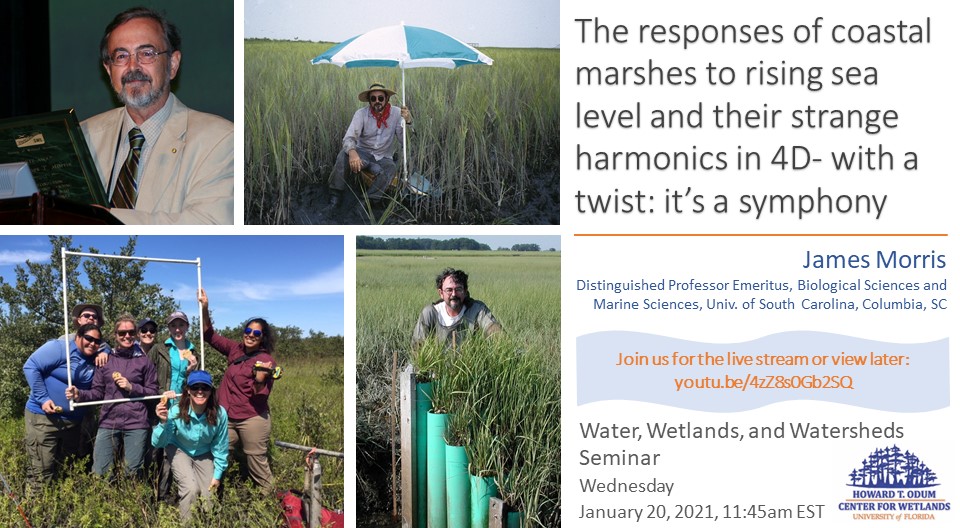January 20, 2021
The responses of coastal marshes to rising sea level and their strange harmonics in 4D- with a twist: it’s a symphony
James Morris, Distinguished Professor Emeritus, Biological Sciences, Baruch Institute for Marine & Coastal Sciences, University of South Carolina, Columbia, SC
Join us for the live stream Jan 13, 11:45am EST, or view later: https://youtu.be/4zZ8s0Gb2SQ
Abstract
The objectives of this research have been to learn how the primary productivity of saltmarshes is regulated and how the vegetation responds to sea-level rise (SLR). I will summarize long-term data collected in marshes at North Inlet, SC since 1984, leading to development of marsh equilibrium theory, which is widely used in models of marsh biogeomorphology, such as the Marsh Equilibrium Model and the sediment Cohort Theory Model. Summarizing marsh equilibrium theory: Saltmarshes dominated by monocultures of Spartina alterniflora survive only within a limited vertical range approximately between mean sea level and mean higher high water. Within this range there is an optimum elevation for plant growth and an equilibrium elevation determined by rate of SLR, suspended sediment concentration, and productivity. Feedback maintains this elevation within the vertical range of tolerance of the plant, in equilibrium with sea level, and explains how marshes have kept pace with SLR for millennia when SLR was lower than today. S. alterniflora adapts to changes in SLR and appears to orchestrate the nutrient cycles that support its productivity. At North Inlet these cycles show a high degree of order and self-determination. Sulfate reduction fed by organic compounds released by the plants appears to be a key determinant of this coordination of biogeochemical cycles. However, SLR at North Inlet now exceeds a tipping point, and marshes there will drown in coming decades.
Bio
Dr. Morris is a broadly trained environmental scientist, a distinguished professor emeritus of Biological and Marine Sciences at the University of South Carolina, former Director of the Baruch Institute for Marine & Coastal Sciences, and a Fellow of the American Association for the Advancement of Science. He is currently a research professor at UofSC. Honors include the USC Research Foundation Award (2011), and the Society of Wetlands Science Merit Award (2012). He holds degrees in environmental sciences (BA, UVA), biology (MA, Yale) and forestry and environmental studies (PhD, Yale), followed by a postdoctoral position at the Marine Biological Laboratory, Woods Hole. Morris has authored >120 publications, largely focused on coastal wetlands. He is a member of the Conservation International/UNESCO Blue Carbon Working Group. Dr. Morris has a long history of NSF-funded research at North Inlet, SC on the effects of changing sea-level on coastal wetlands. His discovery of a stabilizing feedback between marsh primary production, vertical marsh accretion, and sea-level rise has had a significant impact on the fields of biogeomorphology and marsh ecology. He is funded by NSF for a Long-Term Research in Environmental Biology project at North Inlet, and he is part of the Plum Island LTER project and collaborator on other NSF and NOAA-funded projects.

